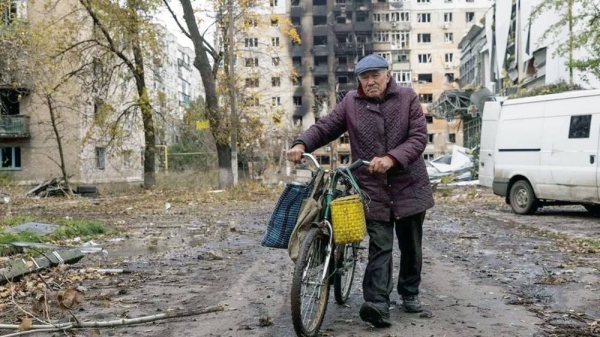
Emily Bit remembers a time when she didn’t feel the constant threat of climate change. Her family lives in American Canyon, in southern Napa county, California, a state now being hit by record high temperatures and devastating wildfires. “It didn’t used to be this bad,” she said.
These days her family has to evacuate their home every summer. Two of her friends lost their homes in Paradise, the town consumed by the 2018 Camp fire disaster, the deadliest in California history. Last year, a wildfire burned the nature reserve behind her local school until it was “entirely black. It was like something from a dystopian novel”.
She worries about her younger siblings, a 12-year-old sister and an eight-year-old brother. “What’s it going to be like in the future?” she asks. She wonders how responsible it would be for her to have children. Bit is 17.
Now, she and fellow student activists are working to break one big link in the fossil fuel chain that is driving climate change: gas stations. There are two proposed new gas stations in her town she wants scrapped. “We don’t need them,” she said.
It’s early days but here in California the initiative is taking off and, if it spreads, it could signal one of the biggest changes in transportation since the car displaced the horse and carriage.
In March, Petaluma in Sonoma county became the first city in the US to ban future gas station construction or any new pumps on existing sites. In July Sonoma county’s Regional Climate Protection Authority voted to explore ways to support the nine cities in the county considering bans of their own. A final vote on the resolution is scheduled for September.
It’s the beginning of what could be a seismic shift. California now has the highest sales of electric vehicles (EVs) in the country. Close to 11% of all new car sales were electric in the first three months of this year and in 2020 the governor, Gavin Newsom, ordered all new cars and passenger trucks sales in California to be zero-emission vehicles by 2035. General Motors and others have pledges to have an all electric vehicle lineup by 2035.
But nationally, just 2.3% of new US car sales in 2020 were plug-in compared to 74.8% in Norway, the country with the highest percentage of adoption. The US had about 276m vehicles registered on its highways in 2019, EVs represent a tiny fraction of that and, given the importance of the second hand market, they are likely to remain so for decades to come without drastic federal action.
‘We need to turn the page’
The world’s first purpose-built gas station was built in St Louis, Missouri, in 1905 and the growth in car ownership – and gas stations – transformed not just the way Americans travel but the landscape of the country. Now there are an estimated 168,000 stations across the country.
Every gallon of gasoline sold adds 9kg (20lb) of carbon dioxide to the atmosphere. In 2019 Americans consumed 142bn gallons of gasoline, producing 1.278bn tonnes (1.4bn tons) of CO2.
The number of gas stations is declining – there were more than 200,000 in 1994 – but the size of gas stations is increasing as “mom and pop” stops give way to massive fueling sites owned by supermarket chains hoping to lure in shoppers with cheap gas.
Electric charging presents an existential threat to those gas stations. About 80% of EV charging is done at home, and it currently takes at least 20 minutes to fast charge an EV, far longer than anyone would ever want to spend in a gas station.
Changing how we fuel our vehicles offers a chance to redefine transportation, said Brant Arthur, program manager at Sonoma Clean Power, the region’s eco-conscious utility. He foresees a time when people will charge their vehicles in the office car park using solar or while shopping or – better yet – drop the car altogether for electric bikes or mass transit. “The general function of the gas station is not the problem,” he said. “But we need to turn the page.”
The page is turning in Sonoma. EV sales are so high that the county is struggling to put in enough charging stations to cope.
But it’s not all good news. The long-term shift to electric and a mass closures of gas stations will create toxic “brown sites” across the country. A typical gas station can spill up to 100 gallons of gasoline annually, according to Coltura, an environmental activism group, poisoning groundwater and making repurposing the sites expensive and difficult. As gas stations disappear these poisoned plots will present an environmental problem of monumental proportions.
That will be another problem to deal with but for now, at least in Petaluma, the end of the gas station is getting off to a surprisingly uncontentious start.
A model for other towns
Petaluma, 37 miles north of San Francisco, has a population of about 60,000 people and is served by 16 gas stations spread across its 14.5 square miles. For D’Lynda Fischer, the Petaluma councilor who spearheaded the ban, 16 is enough. The gas station ban is part of the town’s ambitious goal to become carbon neutral by 2030 – five years before the state’s target.
“Sixty per cent of trips in Sonoma County are under five miles and we are basically flat,” she said. “On top of that, 60% of our greenhouse gas emissions are from transportation. We have an obligation to do this.”
This wine country town, with its antiques stores, farm to table restaurants and shops selling T-shirts reading “Rosé S’Il Vous Plait” and “Let’s Wine About It”, might seem an odd place for a revolution to start. But Petaluma has form.
In the 1970s Helen Putnam, the city’s first female mayor, launched a successful campaign against urban sprawl starting a vicious fight with developers that went all the way to the supreme court.
Fischer is hopeful that Petaluma’s gas station ban can, like Putnam’s sprawl case, start a national debate and – eventually – lead to a moratorium on new gas stations.
Her campaign began with concerns about a proposed huge new Safeway gas station in the town that had attracted opposition in part because the site was near a local school. For Fischer it was also an opportunity to tackle the climate crisis head on. .
“With California on fire, it’s hard to ignore what is happening,” she said. “A year ago I just wanted to bury my head in the sand. Then I pulled myself together and raised my voice.”
One of the big surprises, she said, is that when she explained the proposed ban, most people’s reaction was: “Well duh! Why not?”
Now she is hopeful Petaluma will act as a model for Sonoma, wider California and maybe one day the world.
“We have started a conversation, now how do we leverage this? What can we do next?”
‘It seemed like a no-brainer’
Sonoma’s gas station moratorium owes a lot to local activists Jenny Blaker and Woody Hastings, co-coordinators of Coalition Opposing New Gas Stations (Congas). The pair have helped others across the state, including Bit, to tailor their message, keep their goals realistic and not scare the locals.
British expat Blaker and Hastings look as if they could be in a local folk band or running an organic farm stand. But the pair have proven extremely effective in pressing their agenda and are now in demand from proponents of other, so far, smaller campaigns against news gas stations across the country.
It’s just a first step, said Blaker. “Hopefully the next step is more charging stations, cheaper electric vehicles, better public transport, more bikes. But you have to start somewhere,” she said.
Blaker and Hastings launched a successful campaign against a 16-pump Arco gas station, car wash and store in Cotati, in Sonoma county town. One of their supporters is Mark Landman, a Cotati city council member and a former fire captain.
Landman has seen first-hand just how drastically the local weather has changed. Born and raised in the city, he misses the fogs and rains of his childhood. “It’s hotter, there’s less rain. It’s not just what we are going through now,” he said. “It’s what comes next.”
When he first heard Blaker’s and Hastings’ arguments he wasn’t sure it would work. Gas stations seemed too much of a fixture of the American landscape. But they explained it was a moratorium not a ban – a first step to a greener future. “It seemed like a no-brainer,” Landman said.“There’s something about year-long wildfires that gets people’s attention,” he said.
For Hastings there is a bigger picture. The moratorium is also very much an environmental justice issue, he said. He points to the environmental disasters the oil industry has triggered in the Niger Delta, where 40m litres of oil are spilled every year, or in Ecuador, site of one of the world’s worst ecological disasters.
“Then there are the communities here involved in storage, in refining,” he said, and that’s before the pollution caused by gas stations themselves. “Every drop of gas that comes out of that station is part of a trail of contamination and devastation that leads all the way back to the point of extraction.”
Hastings concedes that Sonoma is not Texas, and if the movement gains traction nationally, it is easy to see it being dragged into the culture wars now raging across the country. “We are in a bubble,” said Hastings. “But as more affordable alternatives for transportation emerge I think it’ll become less of an extreme idea.”
Locally, resistance has so far been almost comically mild. Bit said most of her peers were fully supportive of a ban, except one worried middle schooler. “He wanted a new gas station to get snacks,” she said.
Fischer said her biggest objections came from classic car owners. American Graffiti, George Lucas’s 1973 movie jammed with classic cars, was filmed in the town. “We are not getting rid of all the gas stations,” she told objectors. They seemed appeased.
But will those arguments work outside Sonoma?
“Change requires early adopters and progressive communities,” she said. “But we are not unique. Everyone can see what’s going on. We need to change.”












